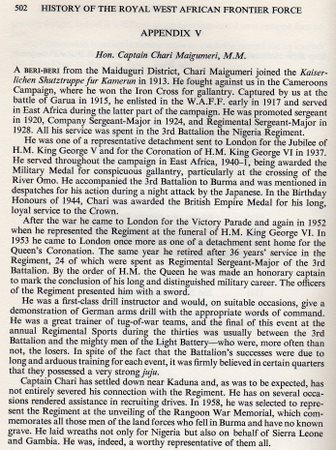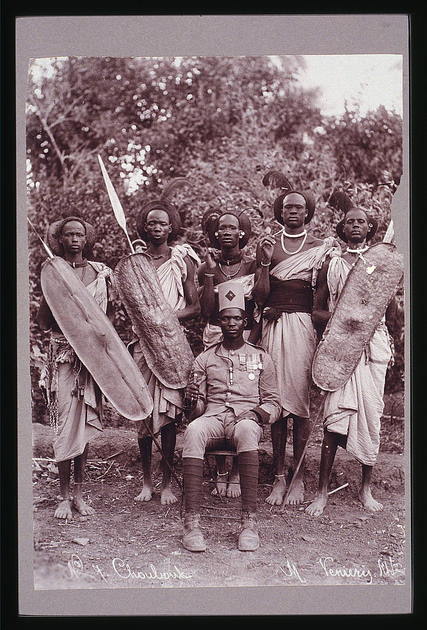
Harry Fecitt
-
Posts
324 -
Joined
-
Last visited
-
Days Won
6
Content Type
Profiles
Forums
Blogs
Gallery
Events
Store
Posts posted by Harry Fecitt
-
-
-
-
-
-
-
-
-
Mervyn
There is a possibly suitable museum at: http://www.rhodesian....org/index.html
You will find Hugh Bomford's contact details at the bottom of the page.
Harry
0 -
Mervyn
Thank you for posting these images - with all the medals on display I think that this is a post-Great War ceremony.
Bechuanaland, I believe, only ever had a small police force.
My instincts tell me that these photos were taken in West Africa, and a research colleague of mine who is an expert on that theatre suggests that this might be the Gold Coast Regiment (GCR) on parade at Kumasi Fort.
If you dig deep you should be able to find out details of post-WW 1 colour presentations to the GCR and then identify the Commanding and Presenting Officers.
Please keep your flow of interesting images coming.
Harry
0 -
Michael
Please may I refer you to pages 126 & 127 of John Arnold's splendid rerence book The African D.C.M. (Published by The Orders & Medals Research Society 1988)
John lists your medal.
You are lucky to have access to it.
Harry
0 -
Mervyn
Greetings
My guess, considering the location and the dates, is that this was a Rhodesia Native Regiment Colour.
I certainly hope it is, as then it is a real discovery.
Harry
0 -
Gentlemen
Anybody researching the 1950s Cyprus Campaign will be interested in this news item: http://www.telegraph.co.uk/comment/persona...-mans-land.html
Harry
0 -
Gentlemen
If anyone is interested in the campaign awards of the late 1890s have a look at:
http://youroldbooksandmaps.co.uk/navy-and-...-1895-1896.html
There is a lot of good background material here and some very good images.
Harry
0 -
Bob's photo in Post 111 sums up for me more than anything why we are floundering around in our overseas theatres these days.
There you see lightly-equipped soldiers leaping off a vehicle with the agility and determination to get amongst the miscreants and take effective action. That's how it was done.
Recently I saw news footage of a British unit that called in an airstrike because one sniper with a standard AK rifle fired at the British base!
After a decent interval heavily-laden British infantry lumbered out of the base on foot, weighed down by protective armour, helmets and massive packs. The enemy was long gone.
For months at a time up on the hill I would live off my mens' rations - chapattis, rice, dal, tinned fish, cheese & meatballs, and dates. Donkeys carried the rations up from the nearest airstrip.
Now our overseas theatres are dependent on massive road convoys of luxury food that apparently is needed today. These convoys, besides being ridiculously expensive to operate, themselves attract attacks and more casualties are incurred from roadside IEDs.
We have lost our military agility, both mentally and physically.
Thank you for showing these images of how it used to be.
Harry
0 -
Irish
Here are some notes that I posted on Great War Forum:
40th PATHANSThe 40th Pathans was a single-battalion regiment with its depot in the northwest Punjab at Sialkot, the former winter capital of the state of Kashmir. The regiment was composed of 1 company of Orakzais, a half company of Afridis and a half-company of Yusufzais, 1 company of Punjabi Musulmans and 1 company of Dogras. The regiment was linked with the 33rd and 46th Punjabis.
The dress uniform was drab coloured with emerald green facings. This was a lively regiment attracting attention wherever it went and being nicknamed the "Forty Thieves" (Major "Ali Baba" Graves of the 42nd Gurkhas had raised the unit at Peshin, Quetta as the only all-Pathan regiment in the Indian Army, but the 1901 linked-battalion system destroyed that unique identity). The stirring regimental march : "Zakhmi Dill", played on srinai (reed pipes) and dhols (drums), was a favourite on band nights along the North-West Frontier, especially when the verses were sung.
In August 1914 the 40th Pathans was in Hong Kong, but after Lord Kitchener remarked that there was a job to be done by such a fine body of men on the Western Front the regiment was ordered to France. Embarking in Kowloon on 26th February 1915 on SS Basilan the regiment disembarked at Marseille on 1st April and marched through the town with its Pukhtan band-musicians playing the Marseillaise.
After inspections by the Indian Corps Commander Sir James Willcocks and by Sir John French the regiment experienced gas attacks and spotter aircraft for the first time during the 2nd Battle of Ypres. After the battle half the regiment was gone, (Killed in Action 24 including the CO, Died of Wounds 10, Missing in Action 11, Wounded in Action 295).
During August and September the regiment was in the trenches near Neuve Chappelle, taking more casualties, but was not committed during the Battle of Loos. In the December 1915 withdrawal of the Indian Infantry Divisions from France the regiment embarked on the 14th at Marseille on HMT Arcadian for an "unknown destination".
The destination was Kilindini where the regiment disembarked on 9th January 1916. On that day Wavell's Arab Rifles were ambushed at Mwele Mdogo, just southwest of Mombasa, losing 30 men killed including Wavell. The 40th Pathans sent two companies immediately to Mwele Mdogo, retaining the two other companies in the defence plan for Mombasa. However the Mwele Mdogo ambush was the last threatening action that the Schutztruppe made on the British East Africa coast and the 40th Pathans was then employed on Line of Communication duties before being placed in the 2nd East African Brigade of 1st Division and allocated to Centre Column.
The 40th Pathans would soon be operating alongside the 2nd Bn the Loyal North Lancashire Regiment during the capture of Dar Es Salaam.
The 40th Pathans would leave behind over 100 dead in East Africa.
I suggest that you obtain a copy of High Noon of Empire - the diary of Lt Col Henry Tyndall 1895-1915 edited by B.A. 'Jimmy' James. Published in 2007 by Pen & Sword. ISBN 978 1 84415 546 0.
This is the only account of the regiment in East Africa that I have found.
Harry
0 -
Paul
Thank you for showing interest - I do not think that there are many other photographs of the East Africa Rifles.
Harry
0 -

Whilst exploring the McMillan Library in Nairobi last year I came across this loose image in a book published in 1900, and I photographed it.
I believe that it shows a detachment of the East Africa Rifles in 1899 waiting for a train to arrive, probably in Nairobi where the first train arrived that year.
At that time the unit still had an Indian contingent, the other companies being composed of Sudanese and Swahilis.
I find the head-dress, particularly of the Indians, interesting.
Has any Gentleman got comments or information to add?
Harry
0 -
Rick & Arthur
I got my answers and posted an article titled "Bronkhorst Spruit" under Harry's Africa in:
http://www.kaiserscross.com/188001/209401.html
Thank you
Harry
0 -

From Hayward & Clarke's history.
Harry
0 -
Thank you Gentleman
What I like about this Senior NCO is that he demonstrates authority in every action, even a pose.
We built our Empire and Protectorate Territories upon the backs of lads like this.
Harry
0 -
Gentlemen
If you go here: http://lcweb2.loc.gov/cgi-bin/query
and type in A group of Sudanese
you come to the image at:
[between 1900 and 1927] 1 photographic print. Veniery, M, photographer.
LOT 11356-44 [item] LC-USZC2-6347(color film copy slide)
Harry
0 -

A group of Sudanese
Happy Valentine's Day Gentlemen
This is a Library of Congress photograph kindly sent by Per Finsted in Denmark.
Can anybody speculate as to the soldiers' unit and awards?
Harry
0 -
Blanche St John Bellairs excellent history: The Transvaal War 1880 - 1881 states in the footnote on page 89 that Sergeants Bradley, Maistre and Pears of the 94th Regiment all received distinguished-service medals.
Does she mean that these three were amongst the 20 recipients of the DCM in this campaign?
(Interestingly in the London Gazette of 3 May 1881 Maj Gen Evelyn Wood recommends Private Murray, 92nd Highlanders for a Distinguished Service Medal, but I cannot find trace of such a medal in use in 1881.)
Can any Gentleman advise, please.
0 -
 This plaque on an outer wall of the English Church in Madeira might be of interest to some Gentlemen.
This plaque on an outer wall of the English Church in Madeira might be of interest to some Gentlemen.I say Well Done Johnson Gideon Beharry. He was there when his Victoria Cross was won and other commentators were not.
0











SKINNER'S HORSE
in Great Britain: Empire: Colonial Including South Africa & India: Awards, Militaria & History
Posted
When the Regimental title was 1st Bengal Lancers